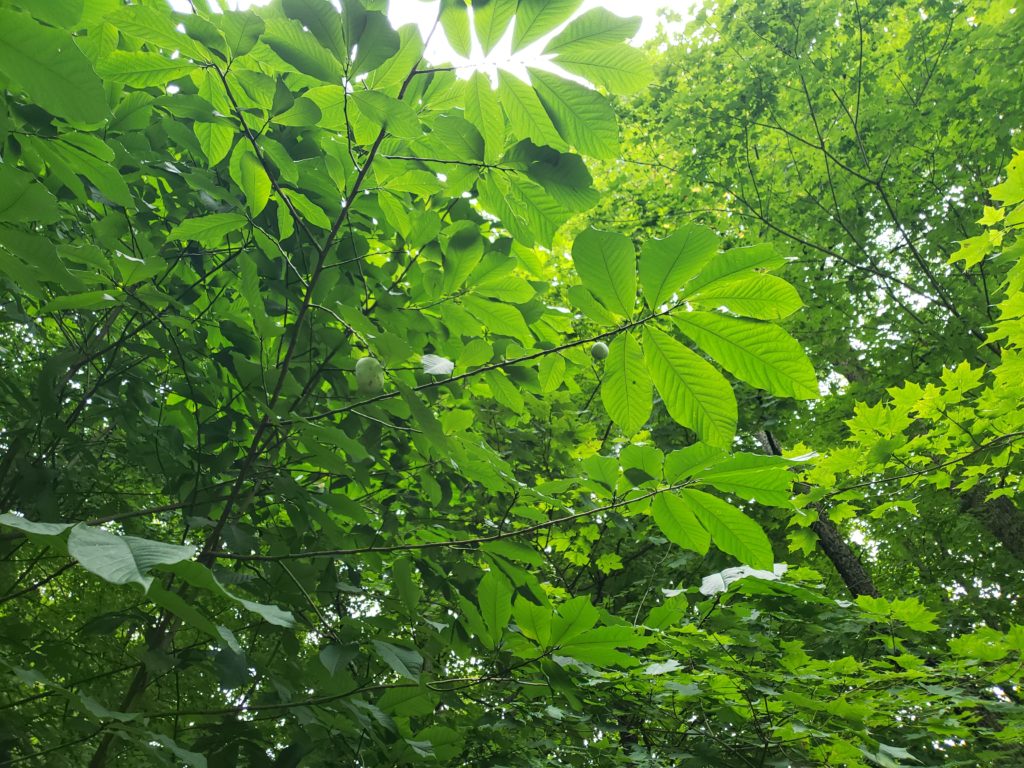How to Ensure Healthy and Productive Trees Year-Round
This post contains affiliate links. I may earn a commission from qualifying purchases at no cost to you.
You’ve done the hard work of tracking down, collecting, and planting your pawpaw (Asimina triloba) tree. Now that it has a forever home, how do you care for the plant to ensure the ultimate prize – sweet, delicious fruit? Here are pro tips to help with successful growing.
Pruning
Pruning is best in late winter or early spring while the trees are still dormant. The fundamentals for apple trees can also be applied to pawpaws. An important goal is to remove dead or diseased branches. Pawpaws are generally pruned to a central leader shape with a focus on: healthy air circulation; removing possible obstructions (e.g., lower branches that are below knee height); and developing a strong framework.
Cage Protection
Don’t lose your pawpaw trees to rogue critters or weed trimmers. You can build a protective cage using chicken wire or garden fence with strong support posts. This will help to create a barrier against wildlife and mechanical damage. In addition, younger trees (less than 36” tall) are sensitive to direct sunlight and need short-term shade protection. The cage will provide a structure to hang burlap or shade cloth.
Mulch
Mulching is important to suppress weed competition, help retain moisture, and regulate soil temperature. Use organic materials such as wood chips, straw, or compost. You should create a three-to-four-foot ring around the tree and spread mulch about two to three inches deep. Be sure to maintain several inches of space away from the base of the tree to prevent potential rot or rodent damage.
Fertilizing
Soil testing is recommended at least one year prior to planting with regular check-ups every three years. Pawpaws need soil pH of 5.5 to 7.0 in a well-draining area. For trees older than one year, apply balanced fertilizer in the spring and/or early summer – either synthetic or organic. An important rule of thumb: don’t fertilize after the Fourth of July. You don’t want the plant to spend energy on new growth that will be vulnerable in the winter.
Water
Be sure to gauge the moisture levels around your pawpaws on a regular basis. Striking the right balance is important: not enough water can be fatal during heat waves but too much water can be dangerous to the plant as well. Overwatering can manifest as yellow leaves and discolored roots. In general, trees need one to two inches of water per week at drip line. During peak summer, the best time to water is in the morning or evening.
Pollination
To ensure successful fertilization, you will need at least two genetically different trees that are ideally eight feet apart. Pawpaw pollinators include flies, beetles, and – humans (hand pollination)! Everyone has unique taste preferences but growers more likely to yield high quality fruit with grafted trees from named cultivars. This includes Neal Peterson, Kentucky State University, Jerry Lehman, and other traditional named varieties (e.g., Overleese, Mango, Sunflower).
Thinning
Similar to apples and pears, a natural drop occurs in early summer (“June drop”) as the young fruit starts to develop. Manual thinning of clusters has benefits. First, this helps prevent stress on outer limbs that could potentially snap from the weight of fruit. Second, research is being conducted to validate that this strategy can yield larger, more flavorful fruit. With shears in hand, you can also thin out any root suckers that may be popping up at the base of your tree.
Fall Clean Up
Pawpaws are hardy and have natural defenses; however, in contrast to popular belief, the trees are not immune to pests. Watch outs include fungus and harmful insects (for example, pawpaw peduncle borers and Asimina webworms). These pests target unhealthy, weaker trees and can spread and cause wider damage. The best defense is to keep the planting area clean by removing infected branches and fallen leaves.
Prevent Southwest Injury
Pawpaws are thin-barked trees and vulnerable to injury such as sunscald (a.k.a. southwest injury) and cracking. In the summer, sunburn occurs due to direct exposure to sunlight and heat. In the winter, rapid and severe weather fluctuations can damage bark tissue. Remedies include tree tubes, cage protection, or painting the tree trunk with a 50/50 solution of white indoor latex paint and water. Stay clear of dark, tight, and non-breathable materials.
Cold Days
Pawpaws have a native range that stretches from northern Florida to the southern edge of Canada. The trees are well suited for USDA Plant Hardiness Zones 5 to 8 with hot, humid summers. Notably, plants need dormant period of at least 400 chilling hours, which makes growing in hot/tropical regions very difficult. When saving seeds, you will need to cold stratify for 90-100 days and keep moist before germinating. Prior to investing the time and energy, check if your area can productively support pawpaws.
Remember that your local extension agent can be a great resource for advice specific to your area.
Visit our Resources page to learn more about growing, find books, and plan for festivals and events.


